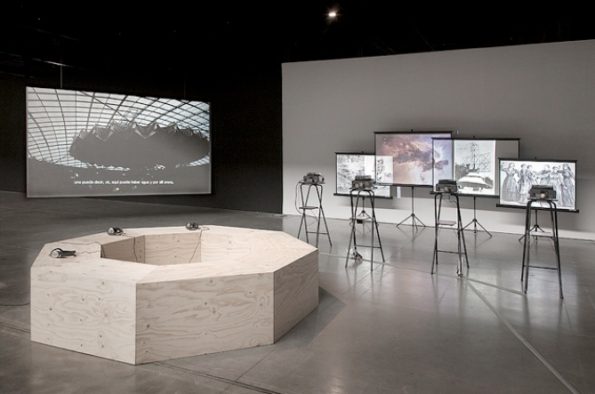Search
To search for an exact match, type the word or phrase you want in quotation marks.
A*DESK has been offering since 2002 contents about criticism and contemporary art. A*DESK has become consolidated thanks to all those who have believed in the project, all those who have followed us, debating, participating and collaborating. Many people have collaborated with A*DESK, and continue to do so. Their efforts, knowledge and belief in the project are what make it grow internationally. At A*DESK we have also generated work for over one hundred professionals in culture, from small collaborations with reviews and classes, to more prolonged and intense collaborations.
At A*DESK we believe in the need for free and universal access to culture and knowledge. We want to carry on being independent, remaining open to more ideas and opinions. If you believe in A*DESK, we need your backing to be able to continue. You can now participate in the project by supporting it. You can choose how much you want to contribute to the project.
You can decide how much you want to bring to the project.

Arqueológica is the exhibition that recently opened at the Matadero Madrid. Curated by Virginia Torrente, the selection shows eight site-specific pieces, realised by as many artists, which seek to reflect upon the present using the archaeological method. That is to say, by studying the past but also the remains of the present. The selected artists appropriate archaeological methods and interpret, in a personal way, historic incidents or specific events. A method that was in its time redefined by Foucault in “The Archaeology of Knowledge”, where he demonstrated that history, more than seeking the truth about the past, works with a mass of documents, organising, distributing and ordering them, to construct a story.
The relation between art and archaeology, as much as art and anthropology, is not new. In 1996 Hal Foster defined ethnographic artists as the new flâneur: nomads of the 20th century. An ethnographic twist, in harmony with the identity policies of the nineties, that enabled practices that united the artistic with the anthropological to arise. Eight years later, in the text “An Archival Impulse”, Foster defined the system of the archive used by artists as a consequence of the erosion of contemporary art and its postmodern critique, while also seeing in it a possibility to open up new paths for action. Many are the artists who have employed these methods, from Robert Smithson and his Hotel Palenque, to Hans Haacke, and creators such as Kader Attia and the work he presented in the last Documenta The Repair from Occident to Extra-Occidental. No doubt indebted to Lévi-Strauss.
What can archaeology bring to contemporary art? What is the vision that art can offer to these disciplines? Does this exhibition offer anything new?
By way of ethnography or alterity, Mariana Castillo Deball exhibits Chinelo en el Matadero: five suits sewn by seamstresses with traditional Mexican artisan skills. Remains from the past that continue into the present but here, out of context, lose something. The work of the Spaniard, Regina de Miguel explores the desert region of Atacama in Chile where the telescopes of Paranal and mummies of Chinchorro converge. Daniel Guzmán uses fieldwork by way of his trip to the city of Paquimé, to recreate an installation, or more of a simulacra, the archaeological work he did there, that also includes all sorts of everyday objects. Diango Hernández in Lecciones de historia tackles the subject of the document, introducing it into an artificial ruin, with half-erased phrases about official Cuban history and African masks by José Guimaraes. Mark Dion in his Lost Property Office gathers together objects found in different districts of the city of Madrid and exhibits them in wardrobes that he has designed. They are contemporary remains that can be found discarded on any street, but by cataloguing and documenting them, they become worthy of the “museum”.
Christian Andersson works with fiction. His installation consists of a white van in the interior of which is projected a fragment of the film On the beach, a futuristic film that talks about a future that has already passed and where a series of scattered objects appear that the spectator is supposed to decipher. Pedro Barateiro composes a diagram with golden pencils, which alludes to drawings of plans and archaeological remains. Lastly, the work of Francesc Ruiz stands out for avoiding the cliché by presenting an investigation of an erotic comic, Sukia that was very successful in the seventies, with the sexual adventures of a vamp and her gay major-domo.
In principle, the initiative to reflect upon archaeology through contemporary art is interesting, if it wasn´t for the fact that the majority of the works resort to the typical idea of archaeology and anthropology, be it through excavation, field work, documentation and the archive or the monument. The lack of depth of some of the pieces and lack of self-criticism, as well as the disconnection between them, means the exhibition ends up being a little disappointing. Ultimately, more than interpreting the present through archaeology, the works seem to be constrained by the concept of the discipline and the subject that has been imposed upon them.

Rosa Naharro endeavours to think about the present, considering its distinct contexts, through culture and contemporary art. Looking at exhibitions, writing, reading, film, music and even conversations with friends serve as her tools. Understanding and interpreting “something” of what we call the world becomes a self-obligation, as well as taking a certain stance, that doesn´t distance her from it. She combines writing for A*Desk with writing her doctoral thesis at the UCM and working with cultural management projects.
"A desk is a dangerous place from which to watch the world" (John Le Carré)